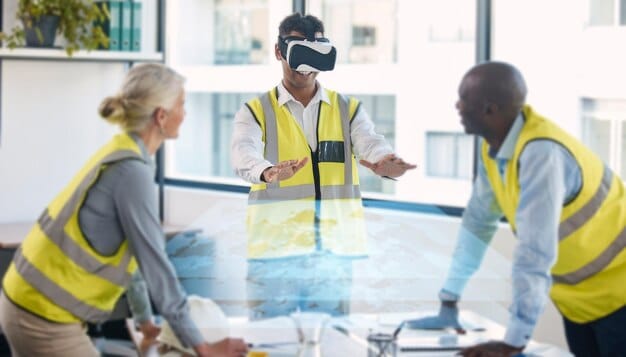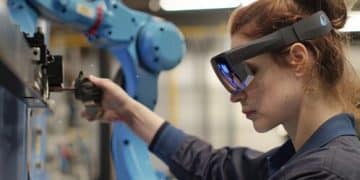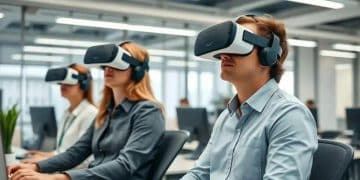VR Training: Reducing US Workplace Accidents by 15% in 2025

US businesses can significantly reduce workplace accidents by 15% in 2025 by strategically implementing virtual reality (VR) training programs that offer immersive, risk-free simulations for high-hazard scenarios.
Are you ready to revolutionize your workplace safety? Discover how US businesses can leverage VR training to reduce workplace accidents by 15% in 2025, creating a safer and more efficient work environment.
Understanding the Urgent Need for Enhanced Workplace Safety in the US
Workplace safety is a critical concern for businesses across the United States. The cost of workplace accidents extends beyond immediate medical expenses and compensation claims. Lost productivity, legal liabilities, and damage to reputation can significantly impact a company’s bottom line. Investing in proactive safety measures is not just ethical; it’s economically sound.
The Financial and Human Costs of Accidents
Workplace accidents result in billions of dollars in direct and indirect costs annually. Beyond the financial burden, the human cost is immeasurable. Injuries can lead to long-term disabilities, reduced quality of life, and even fatalities. Therefore, businesses must prioritize strategies that minimize the risk of accidents.
Traditional Training Methods: Limitations and Challenges
Traditional safety training methods often fall short in effectively preparing workers for real-world hazardous situations. Lectures, manuals, and videos can be informative but lack the immersive experience needed to truly instill safe practices. Moreover, on-the-job training can be risky, especially when dealing with dangerous equipment or environments.
- Difficulty in simulating high-risk scenarios without actual danger.
- Passive learning approaches that hinder retention and engagement.
- Inability to provide personalized feedback and adaptive learning experiences.
- High cost and logistical challenges associated with hands-on training for specialized tasks.
Companies need innovative solutions that address these limitations and create a more engaging and effective learning environment. VR training offers a promising avenue for achieving these goals, providing a safe and immersive platform to prepare workers for a variety of workplace hazards.
To mitigate the risks and improve safety outcomes, US businesses are increasingly exploring innovative training solutions. One such solution gaining traction is the use of virtual reality (VR) training, which offers an immersive and risk-free environment for employees to develop critical safety skills.
The Rise of VR Training for Workplace Safety
Virtual reality (VR) training is rapidly transforming how businesses approach safety education. By immersing users in realistic, simulated environments, VR provides a powerful tool for experiential learning. This technology allows employees to practice responses to hazardous situations without any real-world consequences, leading to better retention and improved decision-making under pressure.
How VR Training Works: Immersive and Interactive Learning
VR training utilizes headsets and interactive simulations to create a fully immersive experience. Users can interact with virtual environments, manipulate objects, and practice safety procedures in a realistic setting. The interactive nature of VR training keeps learners engaged and allows them to apply their knowledge in a practical context.
Benefits of VR Training Over Traditional Methods
Compared to traditional training methods, VR offers several distinct advantages. It allows for the simulation of high-risk scenarios that would be impossible or too dangerous to replicate in real life. It also provides personalized feedback, tracks performance metrics, and adapts the training to individual learning styles. The result is a more effective and efficient learning process.

Real-World Examples of VR Training Applications
VR training is being used across various industries to improve workplace safety. Construction companies use VR to train workers on fall prevention and scaffolding safety. Manufacturing plants use VR to simulate equipment malfunctions and emergency procedures. Healthcare providers use VR to practice complex medical procedures and crisis management. These are just a few examples of how VR is making a tangible difference in workplace safety.
- Construction: Fall prevention, scaffolding safety, and equipment operation.
- Manufacturing: Emergency procedures, hazard recognition, and machine maintenance.
- Healthcare: Surgical simulations, crisis management, and infection control protocols.
- Oil and Gas: Pipeline maintenance, spill response, and safety inspections.
VR training’s immersive approach engages employees more effectively than traditional methods, leading to better knowledge retention and practical application. The ability to simulate high-risk scenarios safely makes VR an invaluable tool for preparing workers for real-world challenges.
Implementing VR Training Programs: A Step-by-Step Guide
Implementing a VR training program requires careful planning and execution. It’s crucial to identify the specific training needs of your organization, select the right VR technology, and design engaging and effective training modules. This section provides a step-by-step guide to help US businesses successfully integrate VR training into their safety protocols.
Step 1: Assess Training Needs and Identify Key Areas
Begin by conducting a thorough assessment of your organization’s training needs. Identify the areas where accidents are most likely to occur and the skills that workers need to improve. Consult with safety managers, supervisors, and employees to gain a comprehensive understanding of the challenges and opportunities.
Step 2: Choose the Right VR Technology and Platform
Select a VR technology and platform that aligns with your training objectives and budget. Consider factors such as the type of VR headset, the software platform, and the availability of pre-built training modules. Ensure that the technology is user-friendly and compatible with your existing IT infrastructure.
Step 3: Design Engaging and Effective Training Modules
Develop VR training modules that are engaging, interactive, and tailored to the specific needs of your workforce. Use realistic simulations, gamified elements, and personalized feedback to enhance the learning experience. Incorporate safety procedures, hazard recognition exercises, and emergency response scenarios.
Step 4: Pilot Testing and Evaluation
Before launching the VR training program company-wide, conduct a pilot test with a small group of employees. Gather feedback on the usability, effectiveness, and engagement of the training modules. Use the feedback to refine the program and address any issues before full-scale deployment.
Step 5: Full-Scale Deployment and Ongoing Monitoring
Once you’ve refined your VR training program, deploy it across your organization. Provide adequate support and resources to ensure that employees can access and utilize the training effectively. Continuously monitor the program’s performance, track accident rates, and gather feedback to identify areas for improvement.
By following these steps, US businesses can implement VR training programs that are tailored to their unique needs and contribute to a safer and more productive work environment. Remember, the success of VR training depends on careful planning, engaging content, and ongoing evaluation.
Measuring the ROI of VR Training: Quantifying the Benefits
Measuring the return on investment (ROI) of VR training is essential for justifying the initial investment and demonstrating its value to stakeholders. By tracking key performance indicators (KPIs) and comparing them to pre-training metrics, businesses can quantify the benefits of VR training in terms of reduced accident rates, improved productivity, and cost savings.
Key Performance Indicators (KPIs) to Track
Identify the KPIs that are most relevant to your organization’s safety goals. Some common KPIs include accident rates, injury severity, near-miss incidents, training completion rates, and employee satisfaction. Track these metrics before and after implementing VR training to measure the impact.
- Accident Rates: Number of accidents per employee or per working hour.
- Injury Severity: Average cost of medical expenses and compensation claims per accident.
- Near-Miss Incidents: Number of near-miss incidents reported per month.
- Training Completion Rates: Percentage of employees who complete the VR training modules.
Calculating Cost Savings and Productivity Gains
Quantify the cost savings and productivity gains resulting from reduced accidents and improved safety practices. Calculate the direct costs of accidents (medical expenses, compensation claims) and the indirect costs (lost productivity, legal liabilities, damage to reputation). Compare these costs to the investment in VR training to determine the ROI.

Case Studies and Success Stories
Share case studies and success stories to demonstrate the real-world impact of VR training. Highlight specific examples of how VR training has helped prevent accidents, improve safety awareness, and enhance overall workplace safety. These stories can be powerful testimonials to the value of VR training.
By accurately measuring the ROI of VR training, US businesses can validate their investment and demonstrate its effectiveness in creating a safer and more productive work environment. Regular evaluation and continuous improvement are key to maximizing the benefits of VR training.
Overcoming Challenges and Ensuring Successful VR Training Implementation
While VR training offers numerous advantages, several challenges can hinder its successful implementation. Addressing these challenges proactively is essential for ensuring that VR training programs meet their intended goals and deliver a positive ROI. This section explores common obstacles and provides strategies for overcoming them.
Addressing Technical Issues and Ensuring Compatibility
Technical issues, such as hardware malfunctions, software glitches, and compatibility problems, can disrupt VR training sessions and frustrate users. To mitigate these issues, ensure that your VR equipment is well-maintained, your software is up-to-date, and your IT infrastructure is robust. Provide technical support to users and establish protocols for troubleshooting common problems.
Managing User Resistance and Promoting Adoption
Some employees may be resistant to adopting new technologies like VR. Address this resistance by clearly communicating the benefits of VR training, providing adequate training and support, and involving employees in the design and evaluation process. Emphasize the positive aspects of VR training, such as its immersive nature and its ability to provide a safe and engaging learning experience.
Ensuring Data Privacy and Security
VR training platforms may collect and store sensitive data about users, such as their performance metrics and training progress. To protect data privacy and security, implement appropriate security measures, such as data encryption, access controls, and privacy policies. Comply with relevant data protection regulations and be transparent about how user data is collected and used.
Integrating VR Training with Existing Safety Programs
VR training should not be viewed as a replacement for existing safety programs but rather as a complement to them. Integrate VR training with your existing safety policies, procedures, and training modules to create a comprehensive and cohesive safety program. Ensure that VR training reinforces key safety messages and complements other training activities.
By proactively addressing these challenges, US businesses can ensure the successful implementation of VR training programs and maximize their impact on workplace safety. A well-planned and executed VR training program can significantly reduce accident rates, improve safety awareness, and create a safer and more productive work environment.
The Future of VR Training in US Workplaces
The future of VR training in US workplaces looks promising, with ongoing advancements in technology and increasing adoption across industries. As VR technology becomes more affordable, accessible, and sophisticated, its potential to transform workplace safety training will continue to grow. This section explores emerging trends and future directions in VR training.
Advancements in VR Technology and Accessibility
VR technology is evolving rapidly, with improvements in headset resolution, processing power, and tracking accuracy. These advancements are making VR experiences more immersive, realistic, and engaging. Additionally, the cost of VR equipment is decreasing, making it more accessible to businesses of all sizes. As VR technology becomes more affordable and user-friendly, its adoption in US workplaces will continue to increase.
Integration with Artificial Intelligence (AI) and Machine Learning
The integration of AI and machine learning with VR training is opening up new possibilities for personalized and adaptive learning experiences. AI-powered VR training platforms can analyze user performance, identify areas for improvement, and customize the training content to individual learning styles. This personalization can significantly enhance the effectiveness of VR training and accelerate the learning process.
Expanding Applications Across Industries
VR training is currently being used in a wide range of industries, and its applications are expected to expand further in the future. As businesses recognize the value of VR training in improving workplace safety and reducing accidents, they will continue to explore new and innovative ways to leverage this technology. From construction and manufacturing to healthcare and transportation, VR training has the potential to transform safety education across all sectors of the US economy.
VR training is poised to play an increasingly important role in shaping the future of workplace safety in the US. By embracing this innovative technology, businesses can create safer, more productive, and more engaging work environments for their employees. Staying informed about the latest developments and trends in VR training is essential for businesses looking to leverage its full potential.
Key Point
Brief Description
Safety Simulation
VR offers risk-free environments to simulate hazardous situations.
Enhanced Retention
Immersive experiences improve knowledge retention among trainees.
Cost Reduction
Decreased accident rates lead to financial savings on insurance premiums and workers’ compensation.
FAQ
Can VR training really reduce workplace accidents?
VR training provides realistic simulations that improve hazard recognition and decision-making skills, directly contributing to accident reduction.
Is VR training expensive to implement?
The initial investment can be significant, but the long-term cost savings from reduced accidents and improved productivity often outweigh the upfront costs.
How do I choose the right VR training program for my business?
Assess your specific training needs, research available VR platforms, and consider factors like customization options, scalability, and user-friendliness.
What kind of safety topics can be covered with VR training?
VR training can cover a wide range of topics, including fall prevention, equipment operation, emergency response, and hazard recognition, among others.
How long does it take to see results from VR training?
Results vary depending on the training program and the specific workplace, but many businesses see a noticeable reduction in accidents within a few months of implementation.
Conclusion
US businesses have a powerful tool at their disposal: VR training. By strategically implementing VR, companies can not only reduce workplace accidents but also create a safer, more efficient, and more engaged workforce.
Read more content





